I decided to sign up for Klusterthon for two reasons:
1. I just finished NYSC, left my last role and have nothing better to do.
2. I wanted to test my skills as a backend developer.
Klusterthon was an event hosted by Stutern. It gathered over 6,000 tech professionals to tackle critical business challenges. Spanning seven days from Nov 20th to Nov 27th, this hackathon aimed to proffer solutions to pressing industry problems.
I was placed in a team with three others: David Ishaya, a UI/UX designer, Sapna Jha, a front-end developer, and one other. I’ll shed more light on that later. The organisers noticed that most teams had incomplete or incompatible groups, and allowed participants to switch teams. That’s how Promise Nwafor, another front-end developer, joined us.
I was drawn to the problem statement titled Simplifying Small Business Payments due to my background in fintech, albeit nine months of experience, and a genuine interest in helping artisans and SMEs to quickly digitize their businesses. The goals of the product were to help business owners manage their clients and track payments. Luckily for me, my teammates had a similar interest.
In a nutshell, the application needed three main features:
1. Business owners should be able to create profiles for their clients.
2. Business owners should be able to issue invoices to their clients.
3. The platform should track these invoices and automatically issue reminders as necessary.
As the sole backend developer, I was to manage and develop the API powering the web application.
The Product
Dashboard
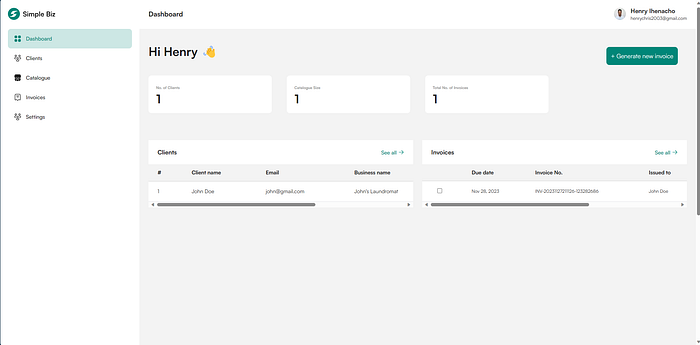
The dashboard was quite simple, just like the rest of the product. You’d get a rundown of the number of registered clients, the size of your product catalogue and the number of issued invoices.
Clients
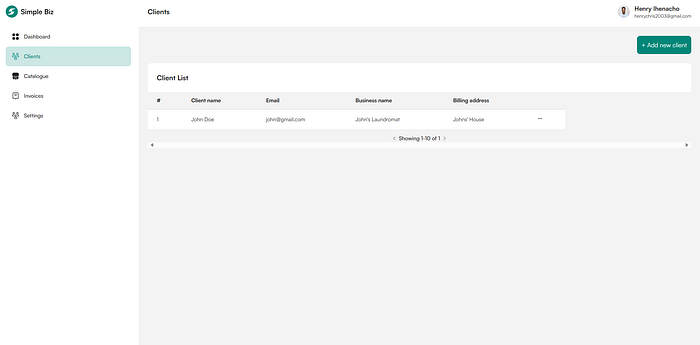
A list of clients, and you can easily add a new one or edit the existing clients.
Catalogue
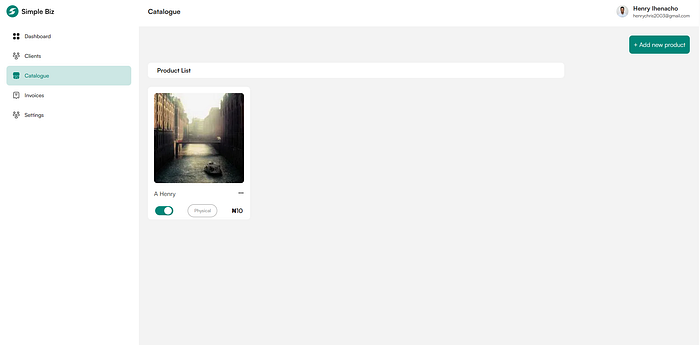
To make it easier to issue the invoices, users could create a catalogue of their products and select from the list when generating an invoice.
Invoices
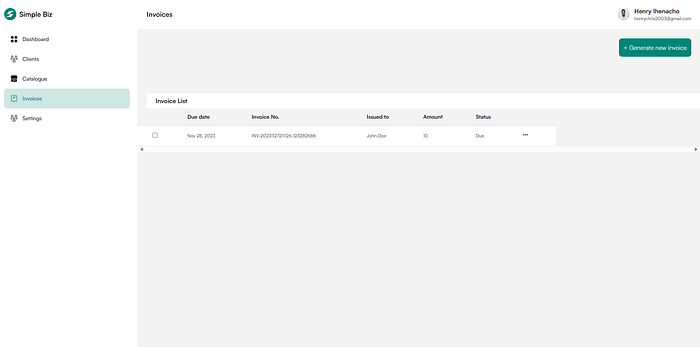
Invoices can be generated and are listed here. As mentioned above, you select the products from the catalog, and they are included in the total and sent along to the client.
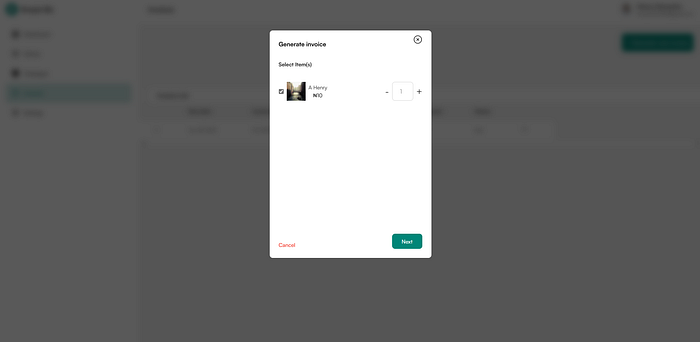
Once an invoice is generated, an initial email is sent to the client, with a link to pay off the invoice.
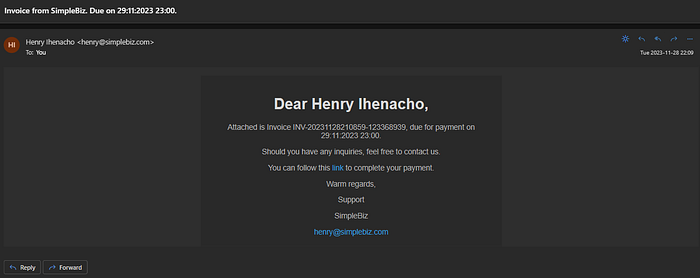
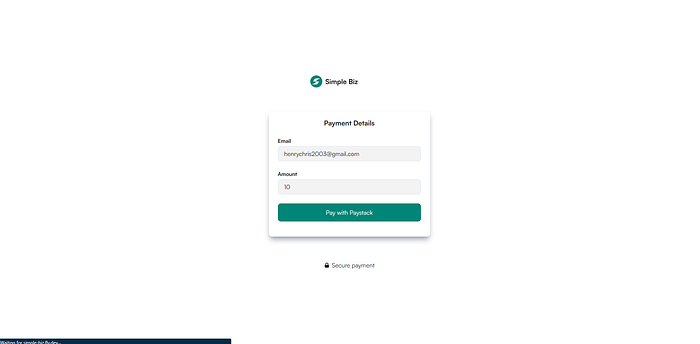
Missing Features
The hackathon lasted only a week, and we had to deal with some teammates vanishing. As such, we had to cut some out.
- Wallet: The wallet system was demo-ready, but there was no time to implement it in the front-end. I also forgot to add it to the Postman collection — a lot was going on 🤧. The plan was for payments to credit SimpleBiz and then the user’s wallet. Users could then request a payout, and funds would be sent to their bank accounts. Easy as pie.
- Custom Notifications: The current notification setup uses Hangfire to schedule reminders. For short-term invoices, a reminder goes out the morning it’s due. While longer-term invoices might get notifications weekly. I planned to allow users to customise that setting, but, no time. I also had not thought up an inexpensive way to get it done.
- Admin Dashboard: I did not see the point of burning time on this for such a short project.
The Development Process
Tools
My stack is .NET. I used the following libraries and tools:
1. Azure Key Vault — to store secrets.
2. Azure Blob Storage — to store notification templates.
3. Docker
4. ErrorOr — I love being able to return errors or the actual value, instead of passing null around the application.
5. Fluent Validation
6. Hangfire — to create and schedule background jobs, specifically reminders.
7. MassTransit & RabbitMQ
8. Ngrok — to expose a local server to the internet.
9. PostgreSQL — the database of choice.
10. Postman — for API testing and documenting
11. Serilog and Seq — for structured logging.
12. Refit — to easily send API requests
13. Railway and Fly.io — for hosting
Requirements Engineering
To start, we talked about the product requirements, user flows, what entities to track and possible use cases. Our PM asked us to take notes, from which she would generate a PRD to help us track what needed work. I used draw.io to visualise what we talked about; this was the result:
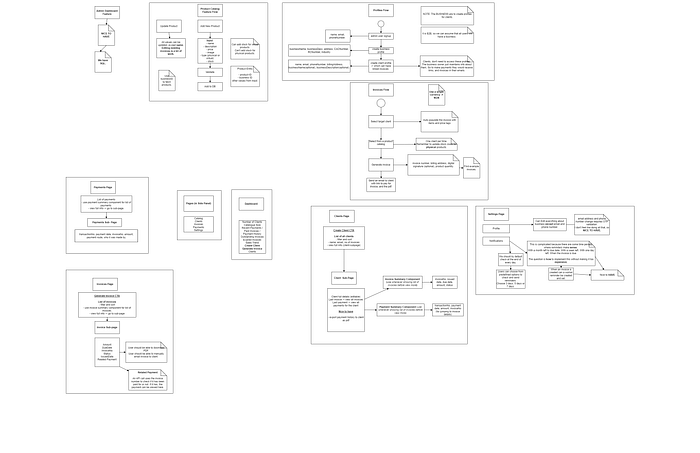
Our PM ended up not returning that day. Or the day after that, or ever. That is how I became both backend dev and product manager.
Architecture
About a month prior, I was building an application using modular monolithic architecture, described here. I used the knowledge from that to bootstrap this project. A modular monolith separates concerns similar to microservices but without the inherent insanity of working with microservices. You also do not need to deploy them separately. It looks like this:
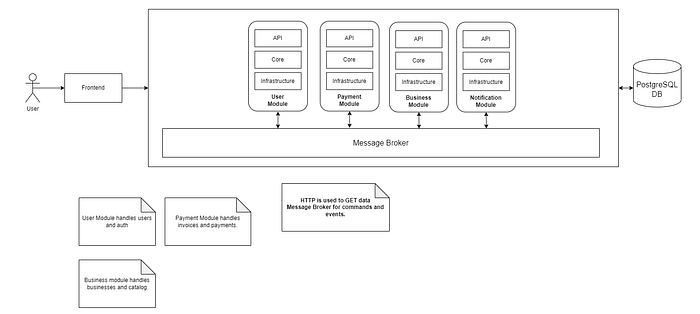
Database Setup
After the requirements discussion, I thought hard about the database and how the various entities would interact. I needed to nail it at the start to prevent excessive refactoring and developer pain. I came up with this:
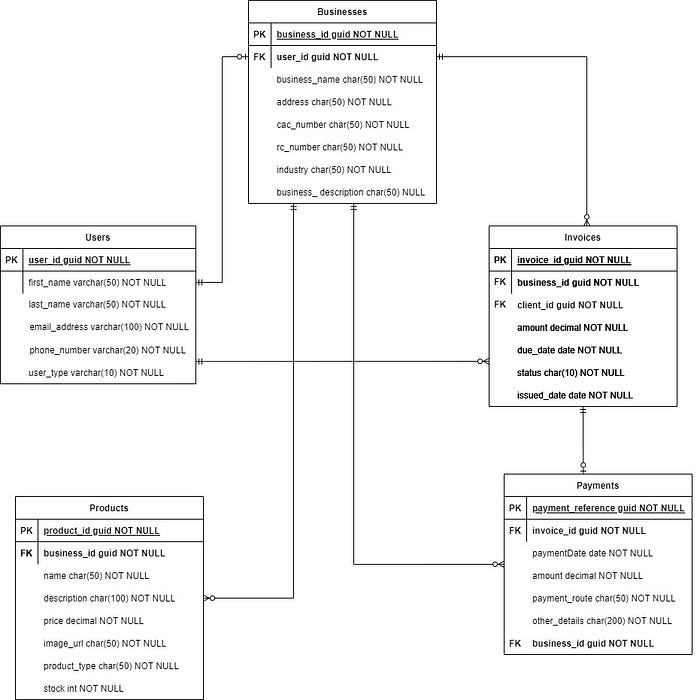
As much as I would like to say it was a one-and-done design, this led to some heavy problems. I discuss the issue in a later section.
I initially planned to have the Users table hold both Clients and Business owners, but then I thought:
“Clients aren’t ever going to access the platform, they only make payments. Why would we need all that data?”.
Instead, I created a Clients table and linked it to the business.
The new ERD looked like this:
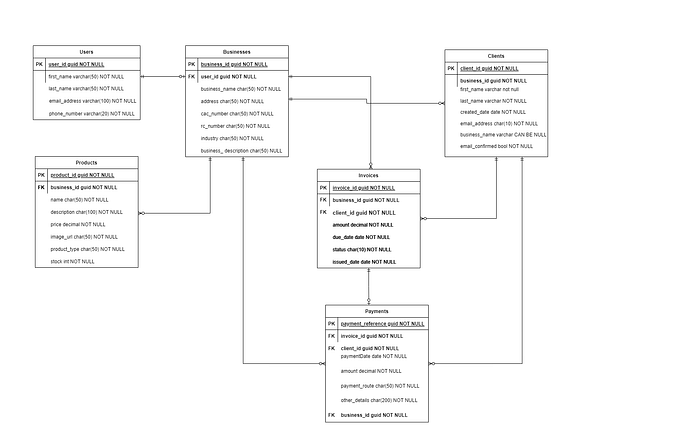
What Module Handles What Data?
In a modular monolith, you define boundaries between the modules. Part of that includes deciding what data they are allowed to access directly. I defined the boundaries like so:
User Module
- Users
Business Module
- Businesses
- Clients
- Products
Payments Module
- Invoices
- Payments
For any data they need and aren’t allowed to directly access, they’d have to communicate with other modules.
Inter-Module Communication
There are two situations where they’d need to communicate:
1. To Fetch Data
2. To Persist Data
To Fetch Data…
My approach was to create contracts, interfaces in C#, and store them in the shared library. Those contracts would be implemented and registered in their related module, and the calling module can use DI to get the data required.
DI = Dependency Injection.
For example, the Invoice module has to check that a business exists, just a common sense check. To do that, it injects and calls the IBusinessService. This interface is implemented by a BusinessService class, and the concrete implementation is registered in the Business module.
If we need to move to microservices, we can create a new implementation that uses an API call instead.
To Persist Data…
For this, I used a message broker. Specifically, I used RabbitMQ with the help of the MassTransit library. If a module needed to create some data, or delete some data in another module, I would publish this event to a queue to ensure that it happened at least once.
Take this example, these entities are all related: Businesses -> Products and Invoices -> Payments. If the application was a monolith with a single database schema, deleting a business from the database would automatically cause a cascade deletion. In this scenario though, the modular nature means a module can only access the entities within its defined boundary.
So, when deleting a Business, I would publish an event to delete all related Clients, Invoices, Products and Payments.
Adding Features
My process has remained the same for some time now. I pull out a notebook and plot out the rough implementation of a feature, and what each step requires. As I write the code, I often think of new approaches or things I had not previously thought of — then I reorder the flow to include them.
When that is done, I go through the code from entry point to conclusion, adding logs and checking that everything is logical. When the endpoint is finalised, I document it in the shared Postman collection for the front-end team to use.
Challenges
Migrations
Handling migrations is a pain in the ass (yet, managing Docker was worse at times). Each module was to handle migrations for entities within its boundaries, but, I didn’t know I was to use different schemas and properly separate the entities.
You see, in C# we use a DataContext to define how we access a database. So, I had a separate context for each module. We also have navigation properties, which allow you to implicitly fetch an entity related to the current one by a foreign key, by including it in its class definition. For example, here’s the original Payment class:
public class Payment
{
[Key, MaxLength(DomainConstants.MaxIdLength)]
public string PaymentReference { get; set; } = SharedLogic.GenerateReference("PAY");
[Column(TypeName = "decimal(18,2)")] public required decimal Amount { get; set; }
public DateTime? DateOfPayment { get; set; }
[MaxLength(DomainConstants.MaxJsonLength)]
public string? OtherDetails { get; set; }
[MaxLength(DomainConstants.MaxEnumLength)]
public string? PaymentChannel { get; set; }
public bool IsCompleted { get; set; }
// navigation properties
[MaxLength(DomainConstants.MaxIdLength)]
public required string BusinessId { get; set; }
public Business Business { get; set; } = null!;
[MaxLength(DomainConstants.MaxIdLength)]
public required string InvoiceId { get; set; }
public Invoice Invoice { get; set; } = null!;
[MaxLength(DomainConstants.MaxIdLength)]
public required string ClientId { get; set; }
public Client Client { get; set; } = null!;
}Notice the Business, Invoice and Client properties underneath their respective IDs? By including them here, I can just write something like context.Include(c => c.Invoice) and it’ll include the data for the Invoice entity related to the payment by its InvoiceId foreign key, without having to make a separate DB call.
In a nutshell, navigation properties handle the SQL JOIN statement.
The problem is, the Business and Client classes are outside the boundaries of the Payment module, so their inclusion would mess with the migrations. The migrations system would create and access tables within the module to represent the tables on the outside, even though the internal tables wouldn’t have any data.
The resolution involved a thorough clean-up: removing the classes, retaining only the Id strings, and implementing careful checks for the existence of related entities before storing the Ids. I also had to establish distinct schemas for each module, specifying the data they could access.
The new, working Payment.cs class:
public class Payment
{
[Key, MaxLength(DomainConstants.MaxIdLength)]
public string PaymentReference { get; set; } = SharedLogic.GenerateReference("PAY");
[Column(TypeName = "decimal(18,2)")] public required decimal Amount { get; set; }
public DateTime? DateOfPayment { get; set; }
[MaxLength(DomainConstants.MaxJsonLength)]
public string? OtherDetails { get; set; }
[MaxLength(DomainConstants.MaxEnumLength)]
public string? PaymentChannel { get; set; }
public bool IsCompleted { get; set; }
// navigation properties
[MaxLength(DomainConstants.MaxIdLength)]
public required string BusinessId { get; set; }
[MaxLength(DomainConstants.MaxIdLength)]
public required string InvoiceId { get; set; }
[MaxLength(DomainConstants.MaxIdLength)]
public required string ClientId { get; set; }
public Invoice Invoice { get; set; } = null!;
}Docker
I use Docker a lot, usually to run software I prefer not to install, such as database servers. I had to use it to share code with the front-end team, making it easier for them to run and use the API during development.
I learned to set up a docker-compose file, bind mounts so Docker could access secrets, and how networking worked inside the container. I only learned what I needed to make things work, though. Now that the hackathon is over, I plan to deepen my understanding of the technology.
NOTE: On the last day of the hackathon, Docker could not find certain files, despite binding them. I had no idea why this was happening and did not have the time to investigate. Instead, I asked the team to download dotnet, which helped us continue working on the project :)
Deployment
On the final day, I woke up at 8 am and began working on deploying my application. Unfortunately, the process took longer than expected and I wasn’t able to complete it until 3 pm. I had planned on using Fly, but by 2 pm, I hadn’t made any progress, so I switched to Railway, which didn’t take as long. I still had to host Seq on Fly because Railway does not support exposing a service to the internet on multiple ports at the moment.
My main challenge during the deployment process was my lack of networking knowledge, which I plan to improve as soon as possible. Dealing with deployments gave me a profound appreciation for Docker though, it’s a remarkable piece of tech.
Teamwork Makes The Dream Work
My teammates were wonderful. They were:
- David Ishaya — UI/UX designer, you can find the Figma here.
- Promise Nwafor — Front-end Developer
- Sapna Jha — Front-end Developer
At the start of the day, we’d mention what we planned to work on and give feedback when close of day came around. Questions were asked and resolved as quickly as possible, sometimes with a quick call. We were free to share feedback on each others work with no one taking it personal. It was great.
NOTE: For this project, the front-end team used React, TypeScript, Next.js and Tailwind.
Closing Thoughts
I’m looking forward to not touching any code for the next week, as I spent every waking hour, 10am to 4am, writing code for 7 days straight. I learned a lot, I met some cool people and I came out knowing I am more capable than I thought. However, there’s still lots more to do and improve on:
- Master Docker
- Delve deeper into networking and the world of DevOps
- Learn to work even faster
The plan is to finetune the existing API after the competition closes on December 19th, and try my hand at the other problem statements . I like building stuff.
I could also use what I’ve learned to work on original ideas. Time will tell.